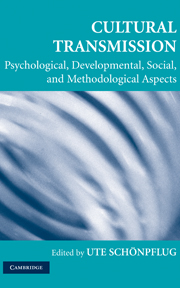Book contents
- Frontmatter
- Contents
- Foreword
- Contributors
- 1 Introduction to Cultural Transmission: Psychological, Developmental, Social, and Methodological Aspects
- 2 Theory and Research in Cultural Transmission: A Short History
- PART ONE EVOLUTIONARY PERSPECTIVE
- PART TWO CROSS-CULTURAL PERSPECTIVE
- PART THREE INTRACULTURAL VARIATIONS
- 14 Intergenerational Transmission of Moral Capital across the Family Life Course
- 15 Similarity of Life Goals in the Family: A Three-Generation Study
- 16 The Intergenerational Transmission of Xenophobia and Rightism in East Germany
- 17 Intergenerational Transmission of Violence
- 18 “Don't Trust Anyone over 25”: Youth Centrism, Intergenerational Transmission of Political Orientations, and Cultural Change
- 19 Value Transmission and Zeitgeist Revisited
- 20 Epilogue: Toward a Model of Cultural Transmission
- Index
- References
17 - Intergenerational Transmission of Violence
Published online by Cambridge University Press: 05 June 2012
- Frontmatter
- Contents
- Foreword
- Contributors
- 1 Introduction to Cultural Transmission: Psychological, Developmental, Social, and Methodological Aspects
- 2 Theory and Research in Cultural Transmission: A Short History
- PART ONE EVOLUTIONARY PERSPECTIVE
- PART TWO CROSS-CULTURAL PERSPECTIVE
- PART THREE INTRACULTURAL VARIATIONS
- 14 Intergenerational Transmission of Moral Capital across the Family Life Course
- 15 Similarity of Life Goals in the Family: A Three-Generation Study
- 16 The Intergenerational Transmission of Xenophobia and Rightism in East Germany
- 17 Intergenerational Transmission of Violence
- 18 “Don't Trust Anyone over 25”: Youth Centrism, Intergenerational Transmission of Political Orientations, and Cultural Change
- 19 Value Transmission and Zeitgeist Revisited
- 20 Epilogue: Toward a Model of Cultural Transmission
- Index
- References
Summary
INTRODUCTION
Both in clinical and in developmental psychology, there seems to be clear evidence that experiences of violence in childhood lead to a heightened risk of parents later using violence toward their own children. In general, beaten children are the beating parents of the next generation. Although this insight has not been confirmed as direct causal evidence, the postulated relationship is not really disputed. Straus (1980b) was able to prove this linear positive relationship between the frequency of experiences of violence and the probability of one's own use of violence: In his study, mothers who were victims of domestic violence as teenagers showed – with nearly 30% – the highest rate of active child maltreatment. Other empirical studies have also shown a link between an adult's acceptance of violence and his or her own early violence experience. Bower and Knutson (1996) questioned approximately 1,359 students and ascertained that the participants with experiences of violence in their childhood were inclined to play down the severity of the violence suffered.
Some of the results of research on intergenerational transmission of violence suffer from methodological difficulties because they are based only on clinical findings with a small sample size, which does not allow inferences to be made in favor of or against the general theoretical assumptions. One of the main weaknesses in clinical findings is that a control group is often lacking. These methodological problems have been avoided in some studies by including control groups and through prospective study designs with risk groups.
- Type
- Chapter
- Information
- Cultural TransmissionPsychological, Developmental, Social, and Methodological Aspects, pp. 391 - 418Publisher: Cambridge University PressPrint publication year: 2008
References
- 1
- Cited by



